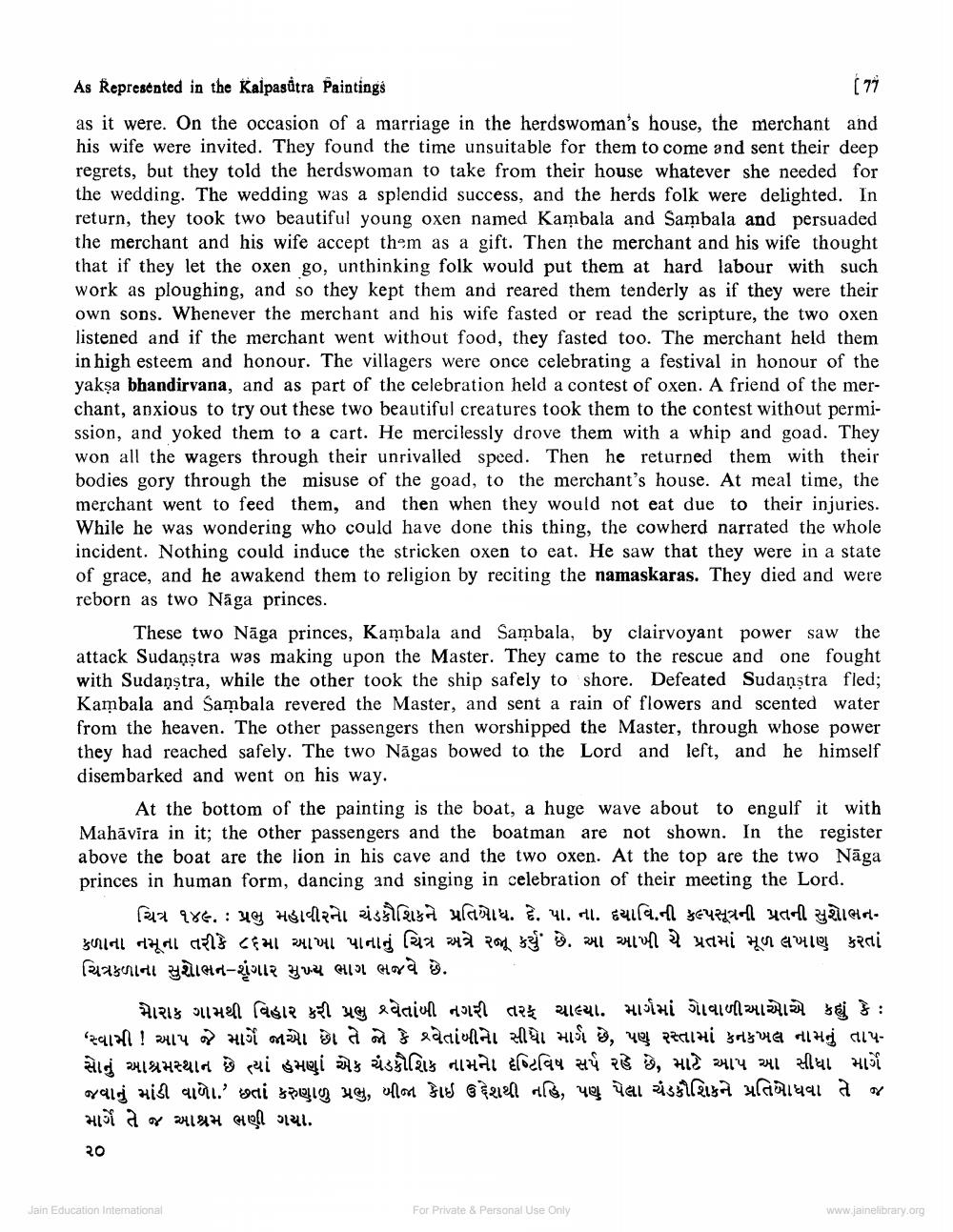________________
As Represented in the Kalpasdtra Paintings
[77
as it were. On the occasion of a marriage in the herdswoman's house, the merchant and his wife were invited. They found the time unsuitable for them to come and sent their deep regrets, but they told the herdswoman to take from their house whatever she needed for the wedding. The wedding was a splendid success, and the herds folk were delighted. In return, they took two beautiful young oxen named Kambala and Sambala and persuaded the merchant and his wife accept them as a gift. Then the merchant and his wife thought that if they let the oxen go, unthinking folk would put them at hard labour with such work as ploughing, and so they kept them and reared them tenderly as if they were their own sons. Whenever the merchant and his wife fasted or read the scripture, the two oxen listened and if the merchant went without food, they fasted too. The merchant held them in high esteem and honour. The villagers were once celebrating a festival in honour of the yakṣa bhandirvana, and as part of the celebration held a contest of oxen. A friend of the merchant, anxious to try out these two beautiful creatures took them to the contest without permission, and yoked them to a cart. He mercilessly drove them with a whip and goad. They won all the wagers through their unrivalled speed. Then he returned them with their bodies gory through the misuse of the goad, to the merchant's house. At meal time, the merchant went to feed them, and then when they would not eat due to their injuries. While he was wondering who could have done this thing, the cowherd narrated the whole incident. Nothing could induce the stricken oxen to eat. He saw that they were in a state of grace, and he awakend them to religion by reciting the namaskaras. They died and were reborn as two Naga princes.
These two Naga princes, Kambala and Sambala, by clairvoyant power saw the attack Sudanṣtra was making upon the Master. They came to the rescue and one fought with Sudanstra, while the other took the ship safely to shore. Defeated Sudanṣtra fled; Kambala and Sambala revered the Master, and sent a rain of flowers and scented water from the heaven. The other passengers then worshipped the Master, through whose power they had reached safely. The two Nagas bowed to the Lord and left, and he himself disembarked and went on his way.
At the bottom of the painting is the boat, a huge wave about to engulf it with Mahāvīra in it; the other passengers and the boatman are not shown. In the register above the boat are the lion in his cave and the two oxen. At the top are the two Nāga princes in human form, dancing and singing in celebration of their meeting the Lord.
ચિત્ર ૧૪૯, : પ્રભુ મહાવીરના ચંડકૌશિકને પ્રતિષેાય. દે. પા. ના. દયાવિ.ની કલ્પસૂત્રની પ્રતની સુશેાભનકળાના નમૂના તરીકે ૮૬માં આખા પાનાનું ચિત્ર અત્રે રજૂ કર્યું છે. આ આખી ચે પ્રતમાં મૂળ લખાણ કરતાં ચિત્રકળાના સુશોભન-શૃંગાર મુખ્ય ભાગ ભજવે છે.
મારાક ગામથી વિહાર કરી પ્રભુ શ્વેતાંબી નગરી તરફ ચાલ્યા. માર્ગમાં ગાવાળાઓએ કહ્યું કે : સ્વામી ! આપ જે માર્ગે જાએ છે તે જો કે શ્વેતાંખીનેા સીધા માર્ગ છે, પણ રસ્તામાં કનકખલ નામનું તાપસાનું આશ્રમસ્થાન છે ત્યાં હમણાં એક ઐડકોશિક નામના દષ્ટિય સર્પ રહે છે, માટે આપ આ સીધા માર્ગ જવાનું માંડી વાળા.' છતાં કરુણાળુ પ્રભુ, ખીજા કાઇ ઉદ્દેશથી નહિ, પણ પેલા ચંડકૌશિકને પ્રતિબેાધવા તે જ માર્ગે તે જ આશ્રમ ભણી ગયા.
૨૦
Jain Education International
For Private & Personal Use Only
www.jainelibrary.org




